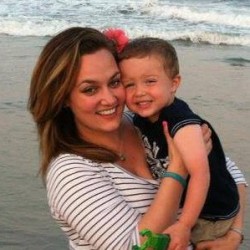AllergyHome is honored to introduce the International Association for Food Protein Enterocolitis (IAFFPE) and Fallon Schultz. Fallon and IAFFPE have been integral in spreading FPIES awareness and supporting those who manage this condition. IAFFPE’s advocacy and educational initiatives have led to impactful change and will continue to improve life for children with FPIES. Thank you Fallon for sharing with us.
Written by Fallon Schultz
Imagine feeding your baby rice cereal (that classic first food) for the very first time. Fast forward two hours later to episodes of vomiting so severe that they leave your child pale, lethargic, and showing signs of shock. Your pediatrician suggests stomach flu, yet the scenario repeats itself with oats, this time landing your child in the ER. This is how the journey begins for many children suffering from Food Protein Induced Enterocolitis Syndrome (FPIES).
What is FPIES?
FPIES is a severe non-IgE reaction in the gastrointestinal system. Unlike most food allergies that produce immediate reactions such as swelling and hives, FPIES reactions are characterized by delayed, profuse vomiting, lethargy, diarrhea, and even shock. The most common triggers are milk and soy, but any food can cause an FPIES reaction. At this time, little is known about FPIES, and few doctors are able to recognize and diagnose the syndrome. Unlike common food allergies, standard skin and blood testing are routinely negative in FPIES patients. There is currently no cure or standardized treatment.
Who am I?
I’m writing today as the mother of a child living with FPIES. I’m also the Founder and Chair of the International Association for Food Protein Enterocolitis (IAFFPE), a 501(c)3 patient organization dedicated to improving the diagnosis, treatment and quality of life for those with FPIES through advocacy, education, support, and research.
 Who is IAFFPE?
Who is IAFFPE?
IAFFPE started in a hospital room in the hours and days following my son’s FPIES diagnosis. Like many other FPIES families, we had been through a long, confusing struggle just to get a diagnosis. I was scared, worried for my son and didn’t know where to turn. I was shocked to learn that there were no formal channels of support or information available to FPIES families. With support and guidance from the Children’s Hospital of Philadelphia, our organization began in 2010 as the FPIES United Family Fund with the purpose of funding FPIES research and education. With early success came the need to establish a broader international foundation to unite the medical community and FPIES families; IAFFPE was officially launched in September 2011.
What we (IAFFPE) do
In a few short years, our volunteer-run organization has taken the lead on a number of initiatives that are bringing real, impactful change to the FPIES community. Here are a few recent highlights:
- Last June, we received news that FPIES finally has an official diagnosis code: K52.21. Securing the ICD-10 code was an ambitious initiative for IAFFPE, and the collective voice of our community made the difference in getting the code passed. When this code is enacted, it will impact our knowledge, awareness, research, and funding for this condition.
- This past summer, every pediatrician in the U.S received an FPIES Fact Sheet developed by IAFFPE’s Medical Advisory Board and distributed by the AmericanAcademy of Pediatrics Section on Allergy and Immunology. This was a huge step in educating frontline providers about FPIES and ultimately reducing the amount of time that patients go without diagnosis.
- IAFFPE is the only organization actively funding FPIES research. In 2013, we funded a new CHOP study that has helped shape our understanding of this condition. The findings of this study were published in The Journal of Allergy and Clinical Immunology: In Practice.
- FPIES was in the spotlight as IAFFPE received media coverage from ABCNews and Good Morning America. Our campaigns for Rare Disease Day and Food Allergy Awareness Week further spread the word about FPIES and strengthen our place in the rare disease and food allergy communities.
- This fall, IAFFPE presented our first national FPIES Education Conference in Philadelphia. This event was a powerful opportunity to bring our community together and hear from expert speakers on a wide spectrum of FPIES-related topics.
- We are well into the process of developing the first consensus guidelines for FPIES. Our Medical Advisory Board is partnering with AAAAI (American Academy of Allergy, Asthma & Immunology) and other leading FPIES researchers. The guidelines will provide a course of action for diagnostic and treatment protocols, research needs, and daily management of the condition.
 IAFFPE and the Food Allergy Community
IAFFPE and the Food Allergy Community
Along the way, we’ve been so appreciative of the support and generosity we’ve received from the food allergy community. More and more, non-IgE is being included in the broader dialogue. IAFFPE is now recognized as the lay organization representing FPIES by AAAAI, and we have been excited by the opportunities to educate and advocate for FPIES patients alongside our colleagues at the AAAAI and ACAAI annual meetings.
Thanks to AllergyHome for this opportunity to share IAFFPE’s efforts to raise FPIES awareness. I invite to you follow us on Facebook and Twitter and visit our website to learn more about FPIES and find out how you can help.

Beautiful explanation of FPIES and your organization, IAFFPE. Finding those trigger foods is a challenge. Thank you for sharing your story and raising awareness on “the silent protein”. Thank you HomeAllergy!